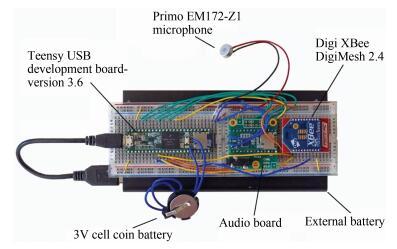Scientist unveil low-cost solution for an audio recorder in a wireless sensor network that records the ecosystem’s sounds

Credit: C.M. Leung Ph.D., University of Brisith Columbia
An international team of researchers has built a new sensor network that can monitor two crucial activities, namely biodiversity, or the variety of life, in a particular habitat or ecosystem, and identification of possible illegal activities such as logging or poaching in protected areas. This wireless recording network is capable of recording an ecosystem’s sounds with the same quality as devices that have been used to date, but it is significantly more energy-efficient and cost-effective. This network is composed of edge computing recorders, or devices that sample and process data at the recording location, with power savings of up to 280%. It promises to significantly streamline the monitoring process of biodiversity and addresses the urgent global need for new assessment methods necessary to maintain the world’s biodiversity balance.
“In this paper, we propose a low cost solution for an audio recorder with onboard audio processing, as part of a wireless sensor network. The developed audio recorder can be used in several different use cases for which no cost effective, scalable biodiversity monitoring solution currently exists, such as to monitor pollinating insects, or to assess the condition of tropical forests by observing vocal animals,” says Victor C. M. Leung, Ph.D., corresponding author and Professor at the Department of Electrical and Computer Engineering, University of British Columbia. “Our tests demonstrate that a collection of acoustic sounds recorded in 1 minute can arrive at the server only 30 seconds after the recording has finished, affording near real-time performance which could be of great value in tracking endangered species, or identifying illegal activity such as logging or poaching in protected areas,” Professor Leung adds.
The study was published in IEEE/CAA Journal of Automatica Sinica in January 2019.
Critical to understanding an ecosystem’s structure and function and predicting future changes is knowing what species inhabit an ecosystem, and how many of each kind there are. A balanced ecosystem has healthy biodiversity levels and is therefore strong enough to withstand stresses such as climate change and predators. Ensuring the ecosystem’s equilibrium is therefore vital to its survival. One way to track biodiversity and ensure its balance is by monitoring the sounds that animals emit as they communicate within their environment. This is also called passive acoustic monitoring, and it has emerged as a powerful method for preserving an ecosystem’s survival. However, the amount of data that is collected requires automated methods that are capable of sampling the sounds across time and space and relaying the data to an accessible storage location. As this requires a lot of power, it remains a technical challenge. As such, there is currently an urgent need for new assessment methods that are both energy efficient as well as cost effective.
“Traditional biodiversity survey methods involve the identification and logging of species, by experts at the recording location, based on what they see and hear at locations of interest. This implies several disadvantages like the vast amount of time and money to get constant results over a long period of time and a wide geographical distance, lack of reliability due to human error. Based on the growing recognition of the ecological significance of the acoustic environment, passive acoustic monitoring is emerging as a promising solution to the urgent, global need for new biodiversity assessment methods,” Professor Leung adds.
In the future, the researchers aim to optimize the system’s versatility as well as efficiency. They also plan to increase battery life by implementing a system sleep mode as well as integrating solar as a second power source for a long-lasting operation. Furthermore, their aims are to improve the audio quality, further reduce costs, increase the number of nodes and install antennas between them so that they can cover a larger network. “A detailed analysis to identify the balance between range and power consumption might be an interesting topic for future enhancements of the wireless recorders,” Professor Leung comments.
###
Fulltext of the paper is available:
http://www.
https:/
IEEE/CAA Journal of Automatica Sinica aims to publish high-quality, high-interest, far-reaching research achievements globally, and provide an international forum for the presentation of original ideas and recent results related to all aspects of automation.
Researchers (including globally highly cited scholars) from institutions all over the world, such as NASA Ames Research Center, MIT, Yale University, Stanford University, Princeton University, select to share their research with a large audience through JAS.
We are pleased to announce IEEE/CAA Journal Automatica Sinica (JAS) has its latest CiteScore as 3.18, which ranks it among top 18% (40/224) in the category of “Control and Systems Engineering”, and top 19% (48/251, 32/168) both in the categories of “Information System” and “Artificial Intelligence”. JAS has entered the 1st quantile (Q1) in all three categories it belongs to.
Why publish with us: Fast and high quality peer review; Simple and effective online submission system; Widest possible global dissemination of your research; Indexed by IEEE, ESCI, EI, Scopus, Inspec.
JAS papers can be found at http://ieeexplore.
Media Contact
Yan Ou
[email protected]
Related Journal Article
http://dx.



